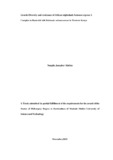| dc.description.abstract | African nightshade, Solanum nigrum L .is one of the most significant leafy vegetable rich in nutritional and medicinal value, and can be used to feed people with human immune deficiency virus, HIV/AIDS in Kenya. There is limited information available of this species that hinders its sustainable conservation and development. Limited information on the crop pests and diseases also present major challenges that limit production of the African nightshade species since farmers are still using farm saved seed which is a danger of inadvertently spreading quarantine pest and diseases like Ralstonia solanacearum. Genetic diversity can be utilized in breeding programs to develop improved African nightshade accessions that are high yielding for both leaf and fruit and resistant to biotic and abiotic stresses. The aim of this study was to evaluate the existence of genetic diversity in African nightshade accessions through morphological and genotypic characterization and also existing inherent resistance to bacterial wilt Ralstonia solanacearum through screening in the field and greenhouse studies. A total of 30 samples from three counties Bungoma, Kakamega and Trans Nzoia were evaluated. For morphological characterization the African nightshade accessions were planted at Kibabii University farm and scored for several agro morphological characters based on National Bureau of Plant Genetic Resource NBPGR descriptors on following qualitative traits; Leaf surface as Glaborous or pubscent, Colour of ripe fruit as Orange or Dark purple or Black, Stem ridge as Smooth ridges or Dented, Leaf shape as Lanceolate or Ovate or rhomboid, Leaf margin as Sinuate dented or Entire and Inflorescence orientation as Simple or Forked the plant type was scored as Semi erect or erect. Cluster analysis of morphological data was done using PASW Version 20 Statistical software. Results showed that there was phenotypic variation amongst accessions of African nightshade collected from the three counties since they were grouped into two major clusters A and B meaning that there is rich diversity both within and among African nightshade accessions which can be used for the crop breeding work. Molecular characterization was done using SSR markers on 30 African nightshade accessions. 6 SSR primers were used and each primer generated 1polymorphic band. Polymorphic Information Content ranged from 0.4215 to 0.8212 with a mean of 0.5881. The average heterozygosity He=0.9111 for SSR markers used. The dendrogram showed that the accessions grouped into three main clusters showing richness in diversity, it also revealed that the coefficient distance that separated most of the accessions was less than 79.56. These findings show that there were possibilities of crossability among the accessions, Variation among regions was not genetically evident. Screening of the 30 African nightshade accessions, to Ralstonia solanacearum was done in the screen house at Masinde Muliro University of science and Technology. Seedlings were inoculated at four to six leaf stages with 30 ml of 108cfu/ml per seedling in the pot and disease incidence was recorded. The different accessions of Solanum nigrumL, Solanum villosum L from Trans Nzoia, Bungoma and Kakamega counties were identified as susceptible. However, improved accessions of Solanum scabrum L sampled from the African nightshade growing areas in Western Kenya were resistant to bacterial wilt, the accessions that were found to be susceptible, symptoms appeared 4 days after inoculation, while the accessions that were found to be resistant/ tolerant no symptoms were observed even after 14 days after inoculation. The resistant accession of improved variety of Solanum scabrum L can be used in production and also breeding programmes for developing new varieties of the African nightshade crops. | en_US |

